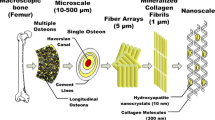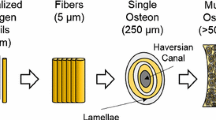Abstract
Blast and impact events regularly cause damage to human tissues. Efforts to improve protective gear are made through numerical simulation of these events where human tissues are exposed to high-rate loading conditions. Accurate simulation results can only be obtained if constitutive models are used that are based on precisely carried out experimental studies. Experimental studies on bone are challenging because of the relatively brittle nature of bone as well as the importance of the bone being in a hydrated state prior to experiments to avoid changing the mechanical properties. Past studies have utilized strain gages which require a period of drying time to bond strain gages to the surface of the bone. In this study, rate dependent fracture and compressive responses of wet human femur bone are investigated with in situ quantitative visualization. The fracture properties of cortical bone are studied transverse to the longitudinal axis of the bone up to high stress intensity factor rates, and the rate dependent compressive response is investigated in both longitudinal and transverse directions. The rate dependent nature of the fracture response, and the compressive behavior of human cortical bone over a range of rates from 0.001–1000 s-1 is discussed with the aid of quantitative visualization.

























Similar content being viewed by others
References
Chu TC, Ransom WF, Sutton MA (1985) Applications of digital-image-correlation techniques to experimental mechanics. Exp Mech 25(3):232–244. doi:10.1007/bf02325092
Sutton MA, Wolters WJ, Peters WH, Ranson WF, McNeill SR (1983) Determination of displacements using an improved digital image correlation method. Image Vis Comput 1(3):133–139. doi:10.1016/0262-8856(83)90064-1
Moussawi A, Lubineau G, Florentin E, Blaysat B (2013) The constitutive compatibility method for identification of material parameters based on full-field measurements. Comput Method Appl M 265:1–14. doi:10.1016/j.cma.2013.06.003
Blaysat B, Florentin E, Lubineau G, Moussawi A (2012) A dissipation gap method for full-field measurement-based identification of elasto-plastic material parameters. Int J Numer Meth Eng 91(7):685–704. doi:10.1002/nme.4287
Florentin E, Lubineau G (2012) Identification of the parameters of an elastic material model using the Constitutive Equation Gap Method. Comput Mech 46(4):521–531. doi:10.1007/s00466-010-0496-y
Ritchie RO, Kinney JH, Kruzic JJ, Nalla RK (2005) A fracture mechanics and mechanistic approach to the failure of cortical bone. Fatigue Fract Eng Mater Struct 28:345–371. doi:10.1111/j.1460-2695.2005.00878.x
Asqharpour Z, Zioupos P, Graw M, Peldschus S (2014) Development of a strain rate dependent material model of human cortical bone for computer-aided reconstruction of injury mechanisms. Forensic Sci Int 236:109–116. doi:10.1016/j.forsciint.2013.11.010
Ural A, Zioupos P, Buchanan D, Vashishth D (2011) The effect of strain rate on fracture toughness of human cortical bone: a finite element study. J Mech Behav Biomed Mater 4(7):1021–1032. doi:10.1016/j.jmbbm.2011.03.011
Ntim MM, Bembey AK, Ferguson VI, Bushby AJ (2005) Hydration effects on the viscoelastic properties of collagen. In: Proceedings: MRS Proc., 898E. L05-02.01-05. doi:10.1557/proc-0898-l05-02
Yamashita J, Furman BR, Rawls HR, Wang X, Agrawat CM (2001) The use of dynamic mechanical analysis to assess viscoelastic properties of human cortical bone. J Biomed Mater Res 58:47–53. doi:10.1002/1097-4636(2001)58:1%3C47::aid-jbm70%3E3.0.co;2-u
Zimmerman EA, Gludovatz B, Schaible E, Busse B, Ritchie RO (2014) Fracture resistance of human cortical bone across multiple length-scales at physiological strain rates. Biomaterials 35:5472–5481. doi:10.1016/j.biomaterials.2014.03.066
Adharpurapu RR, Jiang F, Vecchio KS (2006) Dynamic fracture of bovine bone. Mater Sci Eng C 26:1325–1332. doi:10.1016/j.msec.2005.08.008
Kulin RM, Jiang F, Vecchio KS (2011) Effects of age and loading rate on equine bone failure. J Mech Behav Biomed Mater 4:57–75. doi:10.1016/j.jmbbm.2010.09.006
Norman TL, Vashishth D, Burr DB (1995) Fracture toughness of human bone under tension. J Biomech 28(3):309–320. doi:10.1016/0021-9290(94)00069-g
Zioupos P, Currey JD (1998) Changes in the stiffness, strength, and toughness of human cortical bone with age. Bone 22:57–66. doi:10.1016/s8756-3282(97)00228-7
Wang X, Shen X, Li X, Mauli Agrawal C (2002) Age-related changes in the collagen network and toughness of bone. Bone 31:1–7. doi:10.1016/s8756-3282(01)00697-4
McElhaney J (1966) Dynamic response of bone and muscle tissue. J Appl Phys 21(4):1231–1236
McElhaney J, Fogle J, Byars E, Weaver G (1964) Effect of embalming on the mechanical properties of beef bone. J Appl Phys 19(6):1234–1236
Ohman C, Dall’Ara E, Baleani M, Van Sint JS, Viceconti M (2008) The effects of embalming using a 4 % formalin solution on the compressive mechanical properties of human cortical bone. Clin Biomech 23:1294–1298. doi:10.1016/j.clinbiomech.2008.07.007
Lewis JL, Goldsmith W (1973) A biaxial split Hopkinson bar for simultaneous torsion and compression. Rev Sci Instrum 44:811–813. doi:10.1063/1.1686253
Lewis JL, Goldsmith W (1975) The dynamic fracture and prefracture response of compact bone by split Hopkinson bar methods. J Biomech 8:27–40. doi:10.1016/0021-9290(75)90040-8
Tanabe Y, Tanaka S, Sakamoto M, Hara T, Takahashi H, Koga Y (1991) Influence of loading rate and anisotropy of compact bone. J Phys III 1(C3):305–310. doi:10.1051/jp4:1991343
Ferreira F, Vaz MA, Simoes JA (2006) Mechanical properties of bovine cortical bone at high strain rate. Mater Charact 57:71–79. doi:10.1016/j.matchar.2005.11.023
Lee OS, Park JS (2011) Dynamic deformation of bovine femur using SHPB. Mech Sci Technol 25(9):2211–2215. doi:10.1007/s12206-011-0602-x
Gunnarsson CA, Sanborn B, Foster M, Moy P, Weerasooriya T (2012) Initiation fracture toughness of human cortical bone as a function of loading rate. In: Proceedings: Soc Exp Mech Costa Mesa, CA. doi: 10.1007/978-1-4614-4238-7_7
Gunnarsson CA, Sanborn B, Foster M, Weerasooriya T (2013) Strain and energy based failure criteria for fracture behavior of human cortical bone as a function of loading rate. In: Proceedings: Soc Exp Mech Lombard, Il. doi:10.1007/978-1-4614-4238-7_7
Sanborn B, Gunnarsson CA, Foster M, Moy P, Weerasooriya T (2014) Effect of loading rate and orientation on the compressive response of human cortical bone. ARL-TR-6907
Gustafson MB, Martin RB, Gibson B, Storms DH, Stover SM, Gibeling J, Griffin L (1996) Calcium buffering is required to maintain bone stiffness in saline solution. J Biomech 29(9):1191–1194. doi:10.1016/0021-9290(96)00020-6
ASTM C1421-10 (2010) In: Annual Book of ASTM standards. ASTM, West Conshohocken, PA
Casem D, Weerasooriya T, Moy P (2005) Inertial effects of quartz force transducers embedded in a split hopkinson pressure bar. Exp Mech 45(4):368–376. doi:10.1177/0014485105056090
Chen W, Song B (2010) Split Hopkinson (Kolsky) Bar. Springer, New York, pp 29–77
Chen W, Zhang B, Forrestal MJ (1999) A split Hopkinson bar technique for low impedance materials. Exp Mech 39:81–85. doi:10.1007/bf02331109
ASTM E1820-11 (2011) In: Annual Book of ASTM Standards. ASTM, West Conshohocken, PA
Dong XN, Zhang X, Guo XE (2005) Interfacial strength of cement lines in human cortical bone. Mech Chem Biosyst 2(2):63–68
Dong XN, Gou XE (2004) Geometric determinants to cement line debonding and osteonal lamellae failure in osteon pushout tests. J Biomech Eng 126(3):387–390. doi:10.1115/1.1762901
Nalla RK, Kinney JH, Ritchie RO (2003) Mechanistic fracture criteria for the failure of human cortical bone. Nat Mater 2:164–168. doi:10.1038/nmat832
Nalla RK, Kruzic JJ, Kinney JH, Balooch M, Ager JW III, Ritchie RO (2006) Role of microstructure in the aging related deterioration of the toughness of human cortical bone. Mater Sci Eng C 26(8):1251–1260. doi:10.1016/j.msec.2005.08.021
Vashishth D, Behiri JC, Bonfield W (1997) Crack growth resistance in cortical bone: concept of microcrack toughening. J Biomech 30(8):763–769. doi:10.1016/s0021-9290(97)00029-8
Vashishth D, Tanner KE, Bonfield W (2000) Contribution, development and morphology of microcracking in cortical bone during crack propagation. J Biomech 33(9):1169–1174. doi:10.1016/s0021-9290(00)00010-5
Vashishth D (2004) Rising crack-growth-resistance behavior in cortical bone: implications for toughness measurements. J Biomech 37(6):943–946. doi:10.1016/j.jbiomech.2003.11.003
Vashishth D, Tanner KE, Bonfield W (2003) Experimental validation of a microcracking based toughening mechanism for cortical bone. J Biomech 36(1):121–124. doi:10.1016/s0021-9290(02)00319-6
Reilly DT, Burstein AH (1975) The elastic and ultimate properties of compact bone tissue. J Biomech 8(6):393–405. doi:10.1016/0021-9290(76)90178-0\
Author information
Authors and Affiliations
Corresponding author
Rights and permissions
About this article
Cite this article
Sanborn, B., Gunnarsson, C.A., Foster, M. et al. Quantitative Visualization of Human Cortical Bone Mechanical Response: Studies on the Anisotropic Compressive Response and Fracture Behavior as a Function of Loading Rate. Exp Mech 56, 81–95 (2016). https://doi.org/10.1007/s11340-015-0060-y
Received:
Accepted:
Published:
Issue Date:
DOI: https://doi.org/10.1007/s11340-015-0060-y




